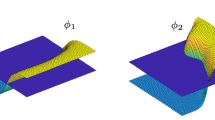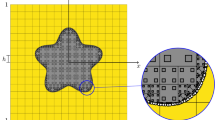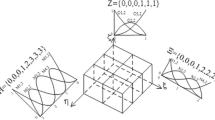Abstract
This paper presents an immersed, isogeometric finite element framework to predict the response of multi-material, multi-physics problems with complex geometries using locally refined discretizations. To circumvent the need to generate conformal meshes, this work uses an extended finite element method (XFEM) to discretize the governing equations on non-conforming, embedding meshes. A flexible approach to create truncated hierarchical B-splines discretizations is presented. This approach enables the refinement of each state variable field individually to meet field-specific accuracy requirements. To obtain an immersed geometry representation that is consistent across all hierarchically refined B-spline discretizations, the geometry is immersed into a single mesh, the XFEM background mesh, which is constructed from the union of all hierarchical B-spline meshes. An extraction operator is introduced to represent the truncated hierarchical B-spline bases in terms of Lagrange shape functions on the XFEM background mesh without loss of accuracy. The truncated hierarchical B-spline bases are enriched using a generalized Heaviside enrichment strategy to accommodate small geometric features and multi-material problems. The governing equations are augmented by a formulation of the face-oriented ghost stabilization enhanced for locally refined B-spline bases. We present examples for two- and three-dimensional linear elastic and thermo-elastic problems. The numerical results validate the accuracy of our framework. The results also demonstrate the applicability of the proposed framework to large, geometrically complex problems.



























Similar content being viewed by others
Notes
Note that the union background mesh is not attained via a set union of the separate hierarchically refined meshes. Instead, elements in this set union that fully contain smaller elements in the set union do not belong to the union background mesh.
References
Annavarapu C, Hautefeuille M, Dolbow JE (2012) A robust Nitsche’s formulation for interface problems. Comput Methods Appl Mech Eng 225–228:44–54. https://doi.org/10.1016/j.cma.2012.03.008
Babuška I, Melenk JM (1997) The partition of unity method. Int J Numer Methods Eng 40:727–758. https://doi.org/10.1002/(SICI)1097-0207(19970228)40:4<727::AID-NME86>3.0.CO;2-N
Bazilevs Y, Calo VM, Cottrell JA, Evans JA, Hughes TJ, Lipton S, Scott MA, Sederberg TW (2010) Isogeometric analysis using t-splines. Comput Methods Appl Mech Eng 199:229–263. https://doi.org/10.1016/j.cma.2009.02.036
Belytschko T, Black T (1999) Elastic crack growth in finite elements with minimal remashing. Int J Numer Methods Eng 45:601–620
Belytschko T, Gracie R, Ventura G (2009) A review of extended/generalized finite element methods for material modeling. Model Simul Materials Sci Eng 17:66. https://doi.org/10.1088/0965-0393/17/4/043001
Bracco C, Buffa A, Giannelli C, Vázquez R (2019) Adaptive isogeometric methods with hierarchical splines: an overview. Discrete Continu Dyn Syst Ser A 39:241–262. https://doi.org/10.3934/dcds.2019010
Buffa A, Giannelli C (2017) Adaptive isogeometric methods with hierarchical splines: optimality and convergence rates. Math Models Methods Appl Sci 27:2781–2802. https://doi.org/10.1142/S0218202517500580
Burman E (2010) La pénalisation fantôme. Comptes Rendus Mathematique 348:1217–1220. https://doi.org/10.1016/j.crma.2010.10.006
Burman E (2012) A penalty-free nonsymmetric Nitsche-type method for the weak imposition of boundary conditions. SIAM J Numer Anal 50:1959–1981. https://doi.org/10.1137/10081784X
Burman E, Hansbo P (2014) Fictitious domain methods using cut elements: III. A stabilized Nitsche method for stokes’ problem. ESAIM Math Model Numer Anal 48:859–874. https://doi.org/10.1051/m2an/2013123
D’Angella D, Kollmannsberger S, Rank E, Reali A (2018) Multi-level bézier extraction for hierarchical local refinement of isogeometric analysis. Comput Methods Appl Mech Eng 328:147–174. https://doi.org/10.1016/j.cma.2017.08.017
de Boor C (1972) On calculating with B-splines. J Approx Theory 6:50–62
de Prenter F, Verhoosel CV, van Zwieten GJ, van Brummelen EH (2017) Condition number analysis and preconditioning of the finite cell method. Comput Methods Appl Mecha Eng 316:297–327. https://doi.org/10.1016/j.cma.2016.07.006
Divi SC, Verhoosel CV, Auricchio F, Reali A, van Brummelen EH (2020) Error-estimate-based adaptive integration for immersed isogeometric analysis. Comput Math Appl 80:2481–2516. https://doi.org/10.1016/j.camwa.2020.03.026
Duarte CA, Babusï I, Oden JT (2000) Generalized finite element methods for three-dimensional structural mechanics problems. Comput Struct 77:215–232
Düster A, Parvizian J, Yang Z, Rank E (2008) The finite cell method for three-dimensional problems of solid mechanics. Comput Methods Appl Mech Eng 197:3768–3782. https://doi.org/10.1016/j.cma.2008.02.036
D’Angella D, Zander N, Kollmannsberger S, Frischmann F, Rank E, Schröder A, Reali A (2016) Multi-level hp-adaptivity and explicit error estimation. Adv Model Simul Eng Sci. https://doi.org/10.1186/s40323-016-0085-5
Elfverson D, Larson MG, Larsson K (2018) Cutiga with basis function removal. Adv Model Simul Eng Sci 5:1–19. https://doi.org/10.1186/s40323-018-0099-2
Embar A, Dolbow J, Harari I (2010) Imposing Dirichlet boundary conditions with Nitsche’s method and spline-based finite elements. Int J Numer Methods Eng 83:877–898. https://doi.org/10.1002/nme.2863
Evans JA, Bazilevs Y, Babuška I, Hughes TJ (2009) n-widths, sup-infs, and optimality ratios for the k-version of the isogeometric finite element method. Comput Methods Appl Mech Eng 198:1726–1741. https://doi.org/10.1016/j.cma.2009.01.021
Garau EM, Vázquez R (2018) Algorithms for the implementation of adaptive isogeometric methods using hierarchical B-splines. Appl Numer Math 123:58–87. https://doi.org/10.1016/j.apnum.2017.08.006
Gerstenberger A, Wall WA (2008) An extended finite element method/Lagrange multiplier based approach for fluid–structure interaction. Comput Methods Appl Mech Eng 197:1699–1714. https://doi.org/10.1016/j.cma.2007.07.002
Giannelli C, Jüttler B, Speleers H (2012) THB-splines: the truncated basis for hierarchical splines. Comput Aided Geom Des 29:485–498. https://doi.org/10.1016/j.cagd.2012.03.025
Giannelli C, Bert J, Speleers H (2014) Strongly stable bases for adaptively refined multilevel spline spaces. Adv Comput Math 40:459–490. https://doi.org/10.1007/s10444-013-9315-2
Gunderman D, Weiss K, Evans JA (2021) Spectral mesh-free quadrature for planar regions bounded by rational parametric curves. Comput Aided Des 130:102944. https://doi.org/10.1016/j.cad.2020.102944
Hughes TJ, Cottrell JA, Bazilevs Y (2005) Isogeometric analysis: CAD, finite elements, NURBS, exact geometry and mesh refinement. Comput Methods Appl Mech Eng 194:4135–4195. https://doi.org/10.1016/j.cma.2004.10.008
Höllig K, Reif U, Wipper J (2001) Weighted extended b-spline approximation of Dirichlet problems. SIAM J Numer Anal 39:442–462. https://doi.org/10.1137/s0036142900373208
Kourounis D, Fuchs A, Schenk O (2018) Toward the next generation of multiperiod optimal power flow solvers. IEEE Trans Power Syst 33:4005–4014. https://doi.org/10.1109/TPWRS.2017.2789187
Lang C, Makhija D, Doostan A, Maute K (2014) A simple and efficient preconditioning scheme for heaviside enriched XFEM. Comput Mech 54(5):1357–1374. https://doi.org/10.1007/s00466-014-1063-8
Makhija D, Maute K (2014) Numerical instabilities in level set topology optimization with the extended finite element method. Struct Multidisc Optim 49:185–197. https://doi.org/10.1007/s00158-013-0982-x
Marussig B, Hughes TJ (2018) A review of trimming in isogeometric analysis: challenges, data exchange and simulation aspects, vol 25. Springer, Netherlands, p 1183101792209. https://doi.org/10.1007/s11831-017-9220-9
Mittal R, Iaccarino G (2005) Immersed boundary methods. Annu Rev Fluid Mech 37:239–261. https://doi.org/10.1146/annurev.fluid.37.061903.175743
Nguyen VP (2012) An introduction to standard and enriched isogeometric analysis through a simple Matlab code isogeometric analysis: a review and computer implementation aspects. Math Comput Simul 117:89–116. https://doi.org/10.1016/j.matcom.2015.05.008
Nitsche J (1971) Über ein variationsprinzip zur lösung von dirichlet-problemen bei verwendung von teilräumen, die keinen randbedingungen unterworfen sind. Abhandlungen aus dem Mathematischen Seminar der Universität Hamburg 36:9–15. https://doi.org/10.1007/BF02995904
Noël L, Schmidt M, Messe C, Evans JA, Maute K (2020) Adaptive level set topology optimization using hierarchical B-splines. Struct Multidiscip Optim 62:1669–1699. https://doi.org/10.1007/s00158-020-02584-6
Noël L, Schmidt M, Doble K, Evans JA, Maute K (2022) XIGA: an extended isogeometric analysis approach for multi-material problems. Comput Mech. https://doi.org/10.1007/s00466-022-02200-y
Parvizian J, Düster A, Rank E (2007) Finite cell method : h- and p-extension for embedded domain problems in solid mechanics. Comput Mech 41:121–133. https://doi.org/10.1007/s00466-007-0173-y
Peskin CS (2002) The immersed boundary method. Acta Numer 11:479–517. https://doi.org/10.1017/S0962492902000077
Remacle J, Lambrechts J, Seny B (2012) Blossom-quad: a non-uniform quadrilateral mesh generator using a minimum-cost perfect-matching algorithm. International 104:1102–1119. https://doi.org/10.1002/nme
Rodgers T (2015) Exploration of process-structure linkages in simulated additive manufacturing microstructures. Harv Dataverse. https://doi.org/10.7910/DVN/KJMK9Z
Saad Y (2003) Iterative methods for sparse linear systems. Soc Ind Appl Math. https://doi.org/10.1137/1.9780898718003
Schillinger D, Rank E (2011) An unfitted hp-adaptive finite element method based on hierarchical b-splines for interface problems of complex geometry. Comput Methods Appl Mech Eng 200:3358–3380. https://doi.org/10.1016/j.cma.2011.08.002
Schillinger D, Ruess M (2015) The finite cell method: a review in the context of higher-order structural analysis of cad and image-based geometric models. Arch Comput Methods Eng 22:391–455. https://doi.org/10.1007/s11831-014-9115-y
Schillinger D, Dedè L, Scott MA, Evans JA, Borden MJ, Rank E, Hughes TJR (2012) An isogeometric design-through-analysis methodology based on adaptive hierarchical refinement of NURBS, immersed boundary methods, and T-spline CAD surfaces. Comput Methods Appl Mech Eng 249–252:116–150. https://doi.org/10.1016/j.cma.2012.03.017
Schillinger D, Ruthala PK, Nguyen A (2016) Lagrange extraction and projection for nurbs basis functions: a direct link between isogeometric and standard nodal finite element formulations. Int J Numer Methods Eng 66:1102–1119. https://doi.org/10.1002/nme.3279/full
Shemon ER, Attaway CW (2014) User manual for exodus ii mesh converter. www.anl.gov
Strouboulis T, Copps K, Babuska I (2000) The generalized finite element method: an example of its implementation and illustration of its performance. Int J Numer Methods Eng 47:1401–1417. https://doi.org/10.1002/(SICI)1097-0207
Terada K, Asai M, Yamagishi M (2003) Finite cover method for linear and non-linear analyses of heterogeneous solids. Int J Numer Methods Eng 58:1321–1346. https://doi.org/10.1002/nme.820
Thiagarajan V, Shapiro V (2016) Adaptively weighted numerical integration in the finite cell method. Comput Methods Appl Mech Eng 311:250–279
Verhoosel CV, van Zwieten GJ, van Rietbergen B, de Borst R (2015) Image-based goal-oriented adaptive isogeometric analysis with application to the micro-mechanical modeling of trabecular bone. Comput Methods Appl Mech Eng 284:138–164. https://doi.org/10.1016/j.cma.2014.07.009
Villanueva CH, Maute K (2014) Density and level set-XFEM schemes for topology optimization of 3-D structures. Comput Mech 54:133–150. https://doi.org/10.1007/s00466-014-1027-z
Acknowledgements
The first, second, fourth, and fifth authors acknowledge the support for this work from the Defense Advanced Research Projects Agency (DARPA) under the TRADES program (Agreement HR0011-17-2-0022). The first author acknowledges partial auspice of the U.S. Department of Energy by Lawrence Livermore National Laboratory under Contract DE-AC52-07NA27344 (LLNL-JRNL-842737). The third and fifth authors acknowledge the support of Sandia National Laboratories under PO 2120843. The fourth and fifth authors acknowledge the support of the National Science foundation under Grant 2104106. The opinions and conclusions presented in this paper are those of the authors and do not necessarily reflect the views of the sponsoring organization.
Author information
Authors and Affiliations
Corresponding author
Additional information
Publisher's Note
Springer Nature remains neutral with regard to jurisdictional claims in published maps and institutional affiliations.
Rights and permissions
Springer Nature or its licensor (e.g. a society or other partner) holds exclusive rights to this article under a publishing agreement with the author(s) or other rightsholder(s); author self-archiving of the accepted manuscript version of this article is solely governed by the terms of such publishing agreement and applicable law.
About this article
Cite this article
Schmidt, M., Noël, L., Doble, K. et al. Extended isogeometric analysis of multi-material and multi-physics problems using hierarchical B-splines. Comput Mech 71, 1179–1203 (2023). https://doi.org/10.1007/s00466-023-02306-x
Received:
Accepted:
Published:
Issue Date:
DOI: https://doi.org/10.1007/s00466-023-02306-x




